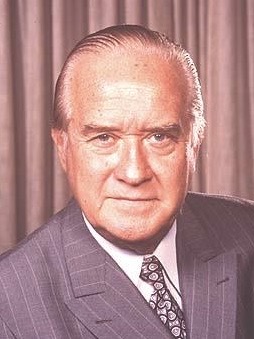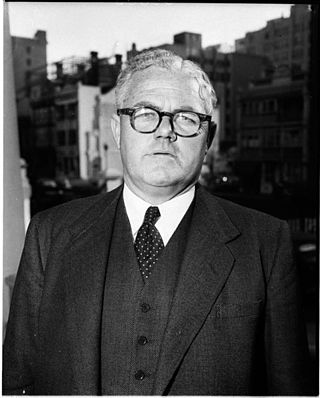
Sir Robert William Askin, GCMG, was an Australian politician and the 32nd Premier of New South Wales from 1965 to 1975, the first representing the Liberal Party. He was born in 1907 as Robin William Askin, but always disliked his first name and changed it by deed poll in 1971. Before being knighted in 1972, however, he was generally known as Bob Askin. Born in Sydney in 1907, Askin was educated at Sydney Technical High School. After serving as a bank officer and as a Sergeant in the Second World War, Askin joined the Liberal Party and was elected to the seat of Collaroy at the 1950 election.

Wagga Wagga is an electoral district of the Legislative Assembly in the Australian state of New South Wales. The district has been held by Independent MP Joe McGirr since the September 2018 by-election.

Lieutenant Colonel Sir Michael Frederick Bruxner was an Australian politician and soldier, serving for many years as leader of the Country Party in New South Wales. Born in the north of the state, Bruxner was educated at The Armidale School and started studies at University of Sydney but later dropped out to take up employment as a grazier and station agent in Tenterfield. After serving in the Citizen Military Forces from 1911, Bruxner enlisted into the Australian Light Horse upon the outbreak of the First World War in 1914. Serving with distinction in Gallipoli, Egypt and Palestine, he was promoted to lieutenant colonel and awarded the Distinguished Service Order.
Members of the New South Wales Legislative Assembly who served in the 36th parliament held their seats from 1950 to 1953. They were elected at the 1950 state election, and at by-elections. The Speaker was Bill Lamb.
A by-election was held for the New South Wales Legislative Assembly seat of Kahibah on 31 October 1953. It was triggered by the forced resignation of Labor MLA Joshua Arthur, after a Royal Commission found his dealings with Reginald Doyle were improper. and was won by independent candidate Tom Armstrong.
Members of the New South Wales Legislative Assembly who served in the 35th parliament held their seats from 1947 to 1950. They were elected at the 1947 state election, and at by-elections. The Speaker was Bill Lamb.
Members of the New South Wales Legislative Assembly who served in the 22nd parliament of New South Wales held their seats from 1910 to 1913. They were elected at the 1910 state election on 14 October 1910. The Speakers were John Cann, Henry Willis and Henry Morton 22 July 1913 – 22 December 1913.

Philip Henry (Pat) Morton was an Australian businessman and politician. Born in Lismore in Northern New South Wales to a prominent political family and educated at Lismore High School, Morton left school at fourteen to be employed in a legal firm, before branching out into various businesses. Moving to Sydney, Morton first entered politics in 1944 as an Alderman on Mosman Municipal Council, rising to be Mayor in 1946. Morton then entered the New South Wales Legislative Assembly on 3 May 1947, representing the Electoral district of Mosman for the Liberal Party.

Sir Vernon Haddon Treatt was an Australian lawyer, soldier, Rhodes Scholar and politician. Born in Singleton, New South Wales and educated at Shore School, Treatt interrupted his studies at the University of Sydney to enlist at the outbreak of the First World War. Serving in the Royal Australian Artillery, Treatt served in France and was awarded the Military Medal. Upon returning to Australia he was awarded a Rhodes scholarship and further educated at New College, Oxford.

The 1938 New South Wales state election was held on 26 March 1938. This election was for all of the 90 seats in the 32nd New South Wales Legislative Assembly and was conducted in single member constituencies with compulsory preferential voting.
James Leo Geraghty was an Australian politician. He was a member of the New South Wales Legislative Assembly from 1941 until 1953. He was a member of the Labor Party (ALP) until 1950 and then sat as an Independent Labor member.
John Wesley Seiffert was an Australian politician and a member of the New South Wales Legislative Assembly from 1941 until his death in 1965. He was a member of the Labor Party (ALP), but stood at an Independent Labor candidate at the 1950 state election.

The 1953 New South Wales state election was held on 14 February 1953. It was conducted in single member constituencies with compulsory preferential voting and was held on boundaries created at a 1952 redistribution. The election was for all of the 94 seats in the Legislative Assembly.
Fred Stanley was an Australian politician. He was a member of the New South Wales Legislative Assembly from 1927 until 1950. During his parliamentary career he was, at various stages, a member of the Labor Party (ALP), the Australian Labor Party (NSW) the Australian Labor Party (Non-Communist) and an Independent Labor member of parliament.
Stephen Roy Heferen was an Australian politician. He was a member of the New South Wales Legislative Assembly from 1941 until 1950. During his parliamentary career he was a member of the Labor Party (ALP) but sat as an Independent Labor member between March and May 1950.

The 1947 New South Wales state election was held on 3 May 1947. It was conducted in single member constituencies with compulsory preferential voting and was held on boundaries created at a 1940 redistribution. The election was for all of the 90 seats in the Legislative Assembly.

The 1962 New South Wales state election was held on 3 March 1962. It was conducted in single member constituencies with compulsory preferential voting and was held on boundaries created at a 1961 redistribution. The election was for all of the 94 seats in the Legislative Assembly.

The McGirr ministry (1950–1952) or Third McGirr ministry was the 54th ministry of the New South Wales Government, and was led by the 28th Premier, Jim McGirr, of the Labor Party. The ministry was the third and final of three consecutive occasions when the government was led by McGirr, as Premier.
This is a list of electoral district results for the 1950 New South Wales state election.
Members of the New South Wales Legislative Council between 1949 and 1952 were indirectly elected by a joint sitting of the New South Wales Parliament, with 15 members elected every three years. The most recent election was on 31 March 1949, with the term of new members commencing on 23 April 1949. The President was Ernest Farrar.












